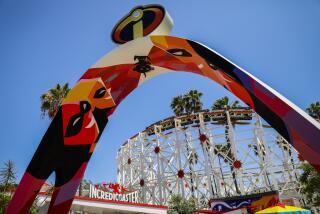Coaster Buffs From Across U.S. Out to Save the Dipper
- Share via
It’s been more than 30 years since Carol Lindemulder rode the Giant Dipper as a high school teen-ager but the memories of hurtling down a 70-foot drop and banking into a 53-degree turn are still “vivid,” she said Thursday at Mission Beach, the site of the historic--and currently defunct--62-year-old roller coaster.
More than a hundred members of the American Coaster Enthusiasts, a group of self-confessed “coaster crazies,” gathered in front of Lindemulder for two reasons: to kick-off their 10th annual national convention and to offer Lindemulder their support for the Giant Dipper restoration project.
Lindemulder, a San Diego native, started the Save the Coaster Committee several years ago to preserve the historic ride and one day to make it operational on a “break-even” basis. Opponents of such efforts have called the Giant Dipper an eyesore, and developers have seen it as an obstacle to the building of a seaside shopping center.
But the committee’s effort to make the ride “available for the people,” and not for the benefit of developers, attracted ACE to the Giant Dipper, said the committee’s president, Norman Starr.
“This is the first time ACE is making a financial contribution to save a roller coaster,” Starr said of the group, which has given about $7,500 for the Giant Dipper.
According to ACE President Randy Geisler, a St. Paul, Minn., resident, the group has always advocated the restoration of roller coasters. He said they were proud to go one step further for the Giant Dipper.
“Our group’s goal is to enjoy, appreciate and preserve roller coasters,” he said. “And we felt there is no place in the world that represents these aims better than the home of the Giant Dipper.”
“Rides like these evoke such excitement. There’s no one who can be neutral about roller coasters. They either thrill you or scare you, and you either love ‘em or you don’t.”
Lindemulder, talking about her ride on the Giant Dipper, falls somewhere in between. She is the first to admit that she had her eyes closed back when the coaster roared down its twisting tracks.
“It felt like my stomach was on top of my head, and my feet felt as if they were a hundred miles away,” Lindemulder said.
Unlike ACE members who describe their passion for such amusement rides, Lindemulder said she herself is not one of the “coaster crazies.” She describes herself as a preservationist, not just of coasters or historic buildings, but of memories.
‘A Fun and Wonderful Place’
“It was a fun and wonderful place,” she said of the Mission Beach Amusement Park, the home of Giant Dipper, otherwise known as the Belmont Earthquake.
“In the 1950s I was a teen-ager at San Diego High,” Lindemulder said, “and in those days when we went on dates we came here to the park and danced in the ballroom.” She cast a glance toward where the ballroom once stood. It has long since been torn down.
“All the girls would be wearing these soft, floaty dresses. And before we would go home, we would take one last ride on the roller coaster . . . It was wonderful!”
Many of those attending the convention echoed such sentiments, if not with the Giant Dipper, then with roller coasters that once stood near their homes. It was the rapid destruction of these “thrillers” that prompted ACE to support preservation projects like the Giant Dipper, Geisler said.
“In the 1930s, the years enthusiasts call the roller coaster’s ‘Golden Age,’ there were about 2,000 rides throughout the country,” Geisler said. “Today, no more than 500 remain.”
And if there ever was a roller coaster to save, this is the one, according to Save the Coaster Committee’s Starr.
The committee, a nonprofit organization, owns the coaster--it was donated to them by William Evans, the owner of the nearby Bahia Hotel--and plans one day to run it again on a “break-even basis,” Starr said.
“It’s the last of a special breed,” he said. “Some of the features on the Earthquake simply cannot be built . . . things like that just aren’t done today.” The ride was designed by “the best of the coaster designers when coasters were in their heyday,” Starr said.
Starr said one of the Giant Dipper’s unique features is its 53 degree banked turn--most coaster tracks today do not exceed banks of 30 degrees.
“Nowadays that’s considered ‘necessity for excitement’ but when the Giant Dipper was created there were no such standards and designers were free to experiment, and raise the limits of riders’ emotions,” Starr said.
He added that the tracks have absolutely no flat spots--they turn side-to-side over the entire course.
That design makes the “Giant Dipper” an engineering marvel and the only roller coaster on the National List of Historic Landmarks. Starr said it earned that designation in 1979.
And the possibility of making it an operating landmark is what has coaster enthusiasts excited.
Assemblywoman Lucy Killea and Steve Peace have managed to secure a promise of $300,000 from the state Legislature to aid the Giant Dipper’s restoration. But that money is still locked in an “intense” budget struggle, according to Starr, and still requires the governor’s approval.
If the committee doesn’t receive the government funding, Starr said, it still will be able to get the coaster running again--it just might take a little longer.
“We’ve raised more than $150,000 on our own. Lots of people from the community have not only given money but have been out here painting and hammering nails. This ride belongs to the people and we’ll get it running again.”
More to Read
Sign up for Essential California
The most important California stories and recommendations in your inbox every morning.
You may occasionally receive promotional content from the Los Angeles Times.













